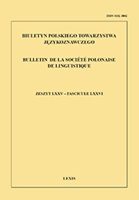O wieloznaczności i funkcjonalności terminu dopowiedzenie. Na przykładzie nowotestamentalnych apokryfów staropolskich
Ambiguity and functionality of the term dopowiedzenie (apposition), exemplified by Old Polish New Testament apocrypha
Author(s): Olga ZiółkowskaSubject(s): Syntax, Historical Linguistics, Western Slavic Languages, Sociology of Religion, Stylistics
Published by: Polskie Towarzystwo Językoznawcze
Keywords: Term; apposition; syntax; Old Polish apocrypha;
Summary/Abstract: The article contributes to the discussion about the possibility of transferring terms between diachronic and synchronic linguistics. Using the term dopowiedzenie (‘apposition’) as an example, we address homonymy and confront various definitions that can be found in the literature. The examples analysed in the article are sourced in Old Polish New Testament apocrypha (Historyja trzech kroli ‘The history of the Three Kings’ and Rozmyślania dominikańskie ‘Dominican Meditations’). The term dopowiedzenie was defined by Laskowski and adopted by, among others, Grochowski, Wiśniewski, Dobaczewski. The definitions in which apposition is seen as an asyntagmatic and contextually dependent unit have been created on the basis of synchronic research and assume, to a large extent, appealing to the language competence of the speaker. Most examples cited in such articles are invented, i.e. created deliberately by the writer. Problems with the adaptation of a term that has developed in the field of synchronic research to diachronic research were already pointed out by Pastuchowa, who suggested that a historical linguist should take language material as a starting point. This, in turn, leads to an observation that the proposed definition and the criteria for the identification of apposition are not applicable to old material. Moreover, the term thus defined is non-intuitive. The term dopowiedzenie was also used by Krążyńska to describe one of the medieval techniques of expanding simple sentences. In this approach, however, the term is blurred, imprecise, although intuitive. Most probably the term was not adapted from one research area to another, but it was created independently. The reason for this can be its transparent word-formation structure and intuitive understanding. It is difficult to propose clear and unambiguous criteria for the extraction of appositions from Old Polish texts. This is due to the fact that we do not know whether a particular language element is an integral part of a sentence (constituent) or whether it is secondary, added (with or without the use of a conjunction). Examining the origin (e.g. the use of a rhetorical figure, the glosses incorporated secondarily in the main text) or the range of the added meanings does not help in resolving the issue. It is the knowledge of the written relic and scholarly intuition that seem to be the key.
Journal: Biuletyn Polskiego Towarzystwa Językoznawczego
- Issue Year: LXXVI/2020
- Issue No: 76
- Page Range: 281-292
- Page Count: 12
- Language: Polish

